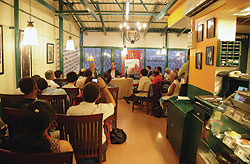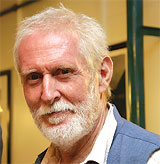
|
|
Tom’s Alter Ego
|
|
In late June, Tom Alter (see interview), an Indian actor of American origin, was the chief guest at a book launch event in south Delhi’s Café Turtle. Alter who’s also an articulate writer and author, found the book—In the Hot Unconscious (An Indian Journey)—well worded, and craftily composed. Eager to catch up with Alter, one of Bollywood’s abiding names, as well as with the book’s author Charles Foster, India Empire’s Farhana Khan and Shayree Chakravarty attended the launch. The interview happened over a few cups of steaming Assam tea
|
|
|
Writing and getting a book published and then having it launched by a celebrity is always a euphoric feeling. That is how it went with author Charles Foster on June 29, at Greater Kailash’s Café Turtle. To do the honours, there was Tom Alter, thespian, columnist, author and so much more. Foster is a writer, barrister and an inveterate traveller.
In the book, as he crosses sacred rivers, navigates the Himalayas, and fights the heat of the south, Foster begins an even more compelling odyssey—a voyage deep within. In flowing prose, Foster philosophizes on the marriage between the East and the West. The writer leaves his thoughts as contemplations, allowing the reader to reflect, question, accept, reject or even simply laugh them off.
For Alter, growing up amid whispering pines was such a joy. He was born in Mussoorie to American missionary parents, studied at the Woodstock School, and has nearly spent all his life in this scenic hill station. A year was spent at America’s Yale University, but he was back in India to join the Film and Television Institute in Pune. Watching the timeless legends Rajesh Khanna and Sharmila Tagore unlocked his desire for a role in Hindi movies. That was 40 years ago.
Since, he’s managed to hitch his wagon to the stars. A Padam Shri awardee, Tom Alter has straddled films, television and theatre, and you wonder if he has any preferences for any one of the mediums. But Alter is clear that he can’t do without all three because he loves acting and he enjoys all three mediums. And what about the films he’s enjoyed working in the most? He holds back a sip of Assam tea to respond: “I have done so many films. It’s very difficult to pick up one.” He’s featured in a number of cameo roles in Bollywood, especially at a time when western actors were few and far between in the industry.
And as for his experiences of working with directors as diverse as Satyajit Ray (Shatranj Ke Khiladi); Raj Kapoor (Ram Teri Ganga Maili) and Shyam Benegal (Junoon), he says articulately, “Ray was controlled brilliance; Raj-sahib was inspired and romantic vision, and Shyam was intellectual art.”
Times have changed, and so has film-making. Alter doesn’t mince much when he says that story lines in past 15 – 20 years have become quite repetitive, may be there’s a need for more ideating. “Earlier we had new story lines. There are now very few independent young film makers who want to make a film and get it released. When I came in the film line, there were young film-makers all over the place making films and getting them released.” It’s more of a business now, people sitting in air-conditioned offices wearing suits, trying their hands at film-making. In the early 1970s, the Bombay film industry was run by people in kurta-pyjamas sitting in non-air conditioned places. What he’s trying to say is that creativity may have found an avoidable short cut, and has somewhere lost its way in the dreary desert sands of dead habit.
| Alter and Foster combine to deliver some fine prose and much insight |
 |
In the Hot Unconscious
Publisher: Tranquebar
Author: Charles Foster
Price: Rs 250/-
Pages: 215 |
PRAISE FOR THE BOOK
Asked on his impressions on the book, he replied “I really enjoyed reading - In the Hot Unconscious. It’s absolutely fantastic and unbelievable. His style of writing and my cousin’s (Stephen Alter) is very similar and that’s a very high compliment.” This book, according to him, is not a travel book, nor can be it typecast as a novel. This man has managed to open his soul, body, mind, and heart. In the end what makes it a great book, says Alter, is that Foster is a brilliant writer. It is a combination of brilliant thinking and brilliant writing—most incredible combination possible and we rarely see it today.” Looks like affable Tom may be talking about his alter ego.
THE OTHER LIFE
After returning from Yale where “he needed to pack up”, Alter taught at a Haryana school. Alter’s been a sports journalist and for long a keen cricketer and sportsperson. He was one of the first people to interview 16-year-old Sachin Tendulkar after his first Test match against Pakistan. Tom Alter was a freelance writer who wrote regularly for magazines like Sports Week, Mid-Day and Sunday Standard newspaper. Even these days he pens a column or three. So what’s his take on the IPL? “I absolutely hate the IPL. What is being played is not cricket but some strange game with the rules of cricket. It’s a tamasha which the corporates love because they make a lot of money out of it,” says Alter without making a semblance of an attempt to hide his disappointment at the complete mockery of traditional cricket that the IPL makes. As a willow-wielder in the past Alter was part of a Bollywood cricket team named Match Cut Club. It also featured such celeb names as Naseeruddin Shah, Satish Shah, Vishal Bhardwaj, Aamir Khan and Nana Patekar.
It’s engaging talking to Tom Alter, sportswriter-turned-thespian. It helps that Tom speaks impeccable Urdu and Hindi and happens to be a fan of Urdu Shayari. “I love Urdu shayari.” He is fond of Gulzar and Mirza Ghalib. “Gulzar’s best shayaris are in his songs like Wo sham kuch ajeeb thi, ye Shaam bhi ajeeb hai. Those are incredible and there are so many songs. Even Ghalib’s ghazals are lyrical and sound so good when sung. As he dipped into his cup for one last sip of his favourite Assam tea, he recited one of Ghalib’s poetry—
“Na tha kuch to khuda tha, kuch na hota to khuda hota
Duboya mujh ko hone ne, na hota main to kya hota.”
|
|
| ALTER SPEAKS

How does an American born Indian school teacher who also happened to be a sports journalist end up in Bollywood?
I took a train at Delhi station and got off at Bombay. That’s how I got to Bollywood.
On a serious note...
I am very serious. (Chuckles)
Which film did you enjoy working in and why?
I have done so many films. Its very difficult to pick up one. But I can tell you one of the books I enjoyed reading the most- “In the Hot Unconscious”. It’s absolutely fantastic and unbelievable. His style of writing and my cousin’s (Stephen Alter) are very similar and that’s a very high compliment.
How do you think Indian cinema has evolved?
Oh god! You are asking the question in which one could write PHD on. Well, in the last 15-20 years, the way we look at film-making has changed. Now films have become a business, run by people sitting in air- conditioned offices wearing suits. The film line when I came in 1970 was not Bollywood . The Bombay Film Industries was not run by people sitting in air conditioned offices wearing suits but by people in kurta-pyjamas sitting in non-air conditioned places. Story lines have become very repetitive. Earlier we had new story lines. There are very few independent young film makers who want to make a film and make on their own and get it released. It’s virtually impossible. When I came in the film line, there were young film- makers all over the place making films and getting them released.
What are your impressions about this book?
This book is not a travel book or a novel book. This man has opened his soul, body, mind, heart. In the end what makes it a great book is that he is a brilliant writer. Today lots of people write books but their writing is rubbish. They can’t write good English but this man is brilliant. So it is a combination of brilliant thinking and brilliant writing- most incredible combination possible and we rarely see it today. This is the first time I have read his book but I have fallen in love with this book.
|
FOSTER ON INDIA

Why this title?
India is a land of Gods and Goddesses and these Gods seem to me the representatives of things that go in the unconscious mind. When you’re walking across the lands of India, you’re walking over something that embodies your own unconscious. So in that sense, India is unique having this physical contact, something which goes in your brain all the time. In order to get peace or stability there has to be some sort of peace between your conscious and unconsciousness that seems to me that a lot of us are devoid of. And it’s also really hot.
What exactly inspired you to write this book?
It wasn’t that I had the idea and I came to India to write the book. I came here first of all very reluctantly, hated India and everything about it. Got ill on the food, loathed the people. But I thought I could make something out of it. I write books to process what’s happened to me because unless I sit down a) the thoughts vanish and b) a lot of things which could be of worth never get grafted into me.
How was your experience the second time round?
I learnt a lot coming to India. I’m marginally less confused than I was. But all that India gave me was confused somehow the next few steps of the journey might be. I’m not an enlightened individual as you can see. (laughs)
India is a young country with half of its population below 25 years. Do you think young readership would be able to grasp the deeply philosophical content of the book?
I hope so. I think age has nothing to do with it really. Shakespeare wrote his plays when he was 13 catering to population of medium age above 30. So in principle I have every reason to believe that younger people are fascinated by the questions that this book tries to address. And I hope it is written in an accessible sort of way. Whenever I meet younger people they are far more desperate than older people to see their grace in the great story and religions, stories into which people try to take their own trip.
How long did it take for you to finish this book?
It’s a very difficult question to answer because the book was put together over several years. |
|
|
|
|
|
|
July 2012
|
|


|
|
|
|
|
|